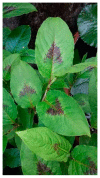Allelopathic Activity of the Invasive Plant Polygonum chinense Linn. and Its Allelopathic Substances
- PMID: 37631179
- PMCID: PMC10459323
- DOI: 10.3390/plants12162968
Allelopathic Activity of the Invasive Plant Polygonum chinense Linn. and Its Allelopathic Substances
Abstract
Polygonum chinense Linn., belonging to the Polygonaceae family, is distributed mostly in northern temperate climates. This species is a high-risk invasive plant and is thought to possess allelopathic potential. This study aimed to isolate and identify the allelopathic substances from P. chinense. Aqueous methanol extracts of P. chinense significantly inhibited the growth of alfalfa and Italian ryegrass seedlings in a species- and concentration-dependent manner. Activity-guided fractionation led to the isolation of two active compounds: dehydrovomifoliol and loliolide. A cress bioassay was used to determine the biological activity of dehydrovomifoliol, and cress, alfalfa, and Italian ryegrass were used to determine loliolide. Dehydrovomifoliol significantly suppressed the seedling growth of cress at the concentration of 1 mM, and the concentrations necessary for 50% growth inhibition (I50 values) of the roots and shoots were 1.2 and 2 mM, respectively. Loliolide significantly suppressed the shoot growth of cress, alfalfa, and Italian ryegrass at the concentration of 1 mM, and the concentrations necessary for I50 values of the shoots and roots were 0.15 to 2.33 and 0.33 to 2.23 mM, respectively. The findings of our study suggest the extracts of P. chinense might have growth-inhibitory potential and that dehydrovomifoliol and loliolide might contribute as allelopathic agents.
Keywords: Polygonum chinense; allelopathic substances; invasive plant.
Conflict of interest statement
The authors declare no conflict of interest.
Figures









References
-
- U.S. Forest Service Pacific Island Ecosystems at Risk (PIER): Plant threats to Pacific Ecosystems. United States Forest Service, United States Department of Agriculture. [(accessed on 2 June 2023)];2010 Available online: http://www.hear.org/pier/index.html.
-
- Galloway D.J., Lepper V.E. Persicaria chinensis—A New Alien Asian Invader?; Proceedings of the 17th Australasian Weeds Conference; Christchurch, New Zealand. 26–30 September 2010; [(accessed on 2 June 2023)]. pp. 174–175. Available online: http://www.caws.org.au/awc/2010/awc201011741.pdf.
-
- eFloras . Flora of North America. Missouri Botanical Garden; St. Louis, MO, USA: Harvard University Herbaria; Cambridge, MA, USA: 2003. [(accessed on 7 April 2023)]. Available online: http://www.efloras.org/flora_page.aspx?flora_id=1.
-
- eFloras . Flora of China. Missouri Botanical Garden; St. Louis, MO, USA: Harvard University Herbaria; Cambridge, MA, USA: 2003. [(accessed on 7 April 2023)]. Available online: http://www.efloras.org/flora_page.aspx?flora_id=2.
-
- Goodland T., Healey J.R. The Invasion of Jamaican montane Rainforests by the Australian Tree Pittosporum undulatum in the Blue Mountains of Jamaica. School of Agricultural and Forest Sciences, University of Wales; Bangor, UK: 1996. 55p
Grants and funding
LinkOut - more resources
Full Text Sources

